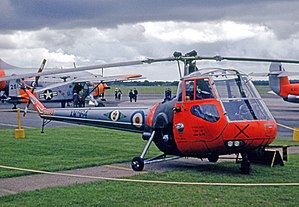Saunders-Roe Skeeter
| Saunders-Roe Skeeter | |
|---|---|
 Saunders-Roe Skeeter in Ternhill (1962) |
|
| Type: | Light multipurpose helicopter |
| Design country: | |
| Manufacturer: | |
| First flight: |
October 8, 1948 (as Cierva Skeeter ) |
| Commissioning: |
1956 |
| Production time: |
1956-1960 |
| Number of pieces: |
approx. 90 |
The Saunders-Roe Skeeter was a two-seat light military helicopter made by the British manufacturer Saunders-Roe and was used for training purposes, observation and as a liaison unit. It was the first helicopter to be used by the British Army .
history
After Saunders-Roe (Saro for short) took over the Cierva Autogiro Company in 1951, Saunders-Roe's newly developed Cierva Skeeter , which was previously only available in the form of two prototypes, was added to the range and made ready for series production. Still, it took another five years before the Saunders-Roe Skeeter could be delivered. The first models all suffered from strong resonance developments, which were due to weak engines. They could only be eliminated in version Srs.5 with the more powerful Gipsy Major engines. Based on the Skeeter, Saunders-Roe developed a larger 5-seat multi-purpose helicopter, the P.531 , which served as the forerunner of the Westland Scout series.
Versions
The first two prototypes under the direction of the Cierva Autogiro Company are counted in the version history. After the takeover by Saunders-Roe, the designation “series” (abbreviated as Srs.) Was introduced. With the exception of a few attempts with runners in series 3 to 5, all skeeters had a wheel chassis with three wheels.
- Cierva W.14 Skeeter 1
- First prototype, equipped with a Jameson FF-1 engine with 78 kW (106 hp). Only one example was built in this configuration. He made the first flight on October 8, 1948.
- Cierva W.14 Skeeter 2
- The second prototype, also only built as a single piece, with which a Gipsy engine with 106 & kW (145 PS) was tested. He first flew in 1949.
Skeeter 1 and Skeeter 2 were handed over to the British Procurement Office in January 1951 as test machines for the Army.
- Skeeter Srs. 3B
- Two examples, equipped with Blackburn- Bombardier 702 engines, which developed 132 kW (180 hp).
- Skeeter Srs. 4th
- This model was designed for the Royal Navy with a Bombardier 704 engine, but only one was built.
- Skeeter Srs. 5
- A civil version that finally solved the resonance problems. There was also only one machine of this version.
- Skeeter Srs. 6th
- Four prototypes with 147 kW (200 hp) Gipsy Major 200 engines in two types:
- Skeeter AOP10
- Three machines went as test copies to the British Army, more precisely the Army Air Corps . There the machines were given the military designation “Air Observation Post 10” (AOP10).
- Skeeter T.11
- A training version with double controls, also for the Army Air Corps, called "Trainer 11".
- Skeeter Srs. 7th
- Of this final production version, 64 units were built from 1958, all for the British Army. They were equipped with the more powerful DH Gipsy Major engines that achieved 158 kW (215 hp). The last copies were delivered in 1960. The Series 7 was also available in two types:
- Skeeter AOP12
- Most of the Skeeter 7 were used in this function for observation.
- Skeeter T.13
- A training version with double control, of which only a few copies were built.
- Skeeter Mk.50
- Export version of the Series 7 for the Air Force . Seven of these were built and delivered, but were never used by the Bundeswehr. One machine from this contingent was used to test the Turmo 603 shaft turbine.
- Skeeter Mk.51
- Four copies of an export version for the German Navy . Like the sister version Mk.50, they were also delivered, but never flown in service with the German Armed Forces.
- Skeeter Srs. 8th
- A civil version, identical to the Series 7. Three units were built, but there were no orders.
Technical specifications
| Parameter | Data Skeeter AOP Mk.12 |
|---|---|
| Construction year | 1958 |
| Manufacturer | Saunders-Roe Ltd. |
| crew | 2 |
| Rotor diameter | 9.76 m |
| Hull length | 8.10 m |
| height | 2.29 m |
| Takeoff mass | 1040 kg |
| Top speed | 167 km / h |
| Range | 340 km |
| Engine | DH Gipsy Major, 158 kW (215 PS) |
See also
literature
- Giorgio Apostolo: World Encyclopedia of Airplanes. Volume 3, Südwest-Verlag, Munich 1984, ISBN 3-517-00851-6 .